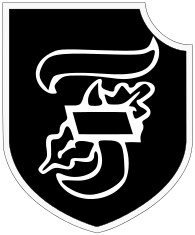10th SS Panzer Division Frundsberg
| 10th SS Panzer Division Frundsberg | |
|---|---|
|
Divisional insignia | |
| Active | 2 January 1943 – 8 May 1945 |
| Country |
|
| Branch |
|
| Type | Panzer |
| Role | Armoured warfare |
| Size | Division |
| Engagements |
Operation Epsom Operation Market Garden Operation Nordwind Halbe Pocket |
The 10th SS Panzer Division Frundsberg or 10.SS-Panzer-Division Frundsberg was a German Waffen SS armoured division during World War II. The division's first battles were in Ukraine in April 1944. Afterwards, the unit was then transferred to the west, where it fought the Allies in France and at Arnhem. The division was moved to Pomerania, then fought south east of Berlin in the Lausitz area until the end of the war.
History
The division received the honor title Frundsberg after the 16th Century German commander Georg von Frundsberg. The division was mainly formed from conscripts. On the night of March 29/30, 1944, a force of 105 heavy bombers of RAF Bomber Command staged an attack on the rail junction at Vaires, where 13 troop trains carrying elements of the division happened to be located while moving to the Eastern front. Members of the French Resistance among the railway workers, who knew of the coming raid, arranged it so that a train carrying naval mines was placed among the troop trains. The mines were detonated by the bombing, and six days later 1,200 SS men had been identified as killed, with many more injured.[1] It first saw action at Tarnopol in April 1944 and later took part in the relief of the German troops cut off in the Kamenets-Podolsky pocket.
It was then sent to Normandy to counter the Allied landings, where, along with the SS Division Hohenstaufen, it took part in fighting against the Allied Operation Epsom. The division suffered heavy casualties and retreated into Belgium before being sent to be reconstituted near Arnhem, where it soon fought the Allied airborne troops during Operation Market Garden at Nijmegen, in the Netherlands, when together with the 9th SS Panzer division it constituted the II SS Panzer Corps. After rebuilding, it fought in the Alsace in January 1945. It was then sent to the Eastern Front, where it fought against the Red Army in Pomerania and then Saxony. Encircled in the Halbe Pocket, the division effected a break and retreated through Moritzburg, before reaching the area of Teplice in Czechoslovakia, where the division surrendered to the US Army at the end of the war.[2]
Günter Grass
German writer and Nobel laureate Günter Grass was an assistant tank gunner with the SS division at the age of 17 in November 1944. He was wounded in action on 25 April 1945 and captured in a hospital.[3]
Commanders
- SS-Standartenführer – Michael Lippert: (1–15 February 1943)
- SS-Gruppenführer – Lothar Debes: (15 February – 15 November 1943)
- SS-Gruppenführer – Karl Fischer von Treuenfeld: (15 November 1943 – 27 April 1944)
- SS-Brigadeführer – Heinz Harmel: (27 April 1944 – 28 April 1945)
- SS-Obersturmbannführer – Franz Roestel: (28 April – 8 May 1945)
Area of operations
- France, (January 1943 – March 1944 on formation)
- Eastern Front, Southern sector (March–April 1944)
- Poland, (April–June 1944)
- France, (June–September 1944)
- Belgium & the Netherlands, (September–October 1944)
- West Germany, (October 1944 – February 1945)
- Northwest Germany, (February–March 1945)
- East Germany and Czechoslovakia, (March–May 1945)
- Surrender and disbandment
References
- ↑ Martin Middlebrook, The Nuremberg Raid, Penguin Books, 1973/1980, p. 82
- ↑ Georg Tessin, Verbände und Truppen der deutschen Wehrmacht und Waffen-SS, Vol. III, p. 188, Osnabrück: Biblio Verlag, 1974
- ↑ Irving, John (19 August 2006). "Günter Grass is my hero, as a writer and a moral compass". London: The Guardian. Archived from the original on 20 August 2006. Retrieved 19 August 2006.
